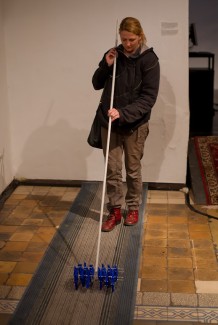The Karpetbeest, a printable Jansen walker
This is a mm scale model of Theo Jansen's Strandbeests suitable for printing with RepRap 3D printers - a work in progress.
Update April 2012: Finally, I finished a six-pairs-of-legs blue specimen for the show at ŠKUC gallery. It walks if you push it around the carpet! A 2m PVC electrician tube is provided to make this more comfortable. :) Rotating joins between printed parts are made with 3mm plastic filament, melted a little into a ball on each side. That works so well I only wish it could be used for everything!
Lots of hexnuts on M3 threaded rod keep the printed backbone parts of the bot nicely parallel and equally spaced. I tried with hotglue and thick copper wire first, but it was hard to get a good bond inside the hole and many of them came unstuck after a while.
Crankshaft pins are held in little holes with superglue. They like to break off and are now the weakest link. I will try epoxy next, and if that doesn't help, switch from straight pins to U or clamp shaped ones which will not "pull out of the hole". Some redesign of the printed part will be necessary for that. Or maybe the plastic filament would work here too, and I'm just not brave enough to try?
The model is built in Blender with lots of boolean modifiers using python scripting. Blender lets me see the motion and assembly before printing and because it's a script it's easy to adjust some parameters after test prints, for instance hole sizes which can be tricky to get right. The script takes Jansen's magic numbers as millimeter measurements and builds all the parts of the leg and frame in the right shapes and sizes.
I'm now (2012) testing new Blender versions with improved booleans code, which is much faster and more stable. But it still chokes sometimes on what I'm asking it to do. When finished, the generated model will be cleaner and more precise. Perhaps OpenSCAD would really be better for all this CSG...
The frame accepts skate bearings into which the crankshaft parts are glued, hopefully giving a smooth and precise circular motion and minimal friction. Hinge axes are 3mm metal pins, like the sled rails in optical drives (CD, DVD), which i've got a few lying around.
Expect more to come soon, as I progress toward a walking unpowered beest, then figure out the propulsion, and finally build a two-motor robot with 2 groups of 3 pairs == 12 legs! I'll put the design files and script up here and on Thingiverse under a free license as soon as I make sure it all fits together well, eliminate the weak spots and adjust the tolerances for good fit where needed.
walk gracefully under wind or other power
- Target environment: Indoors - Carpet


